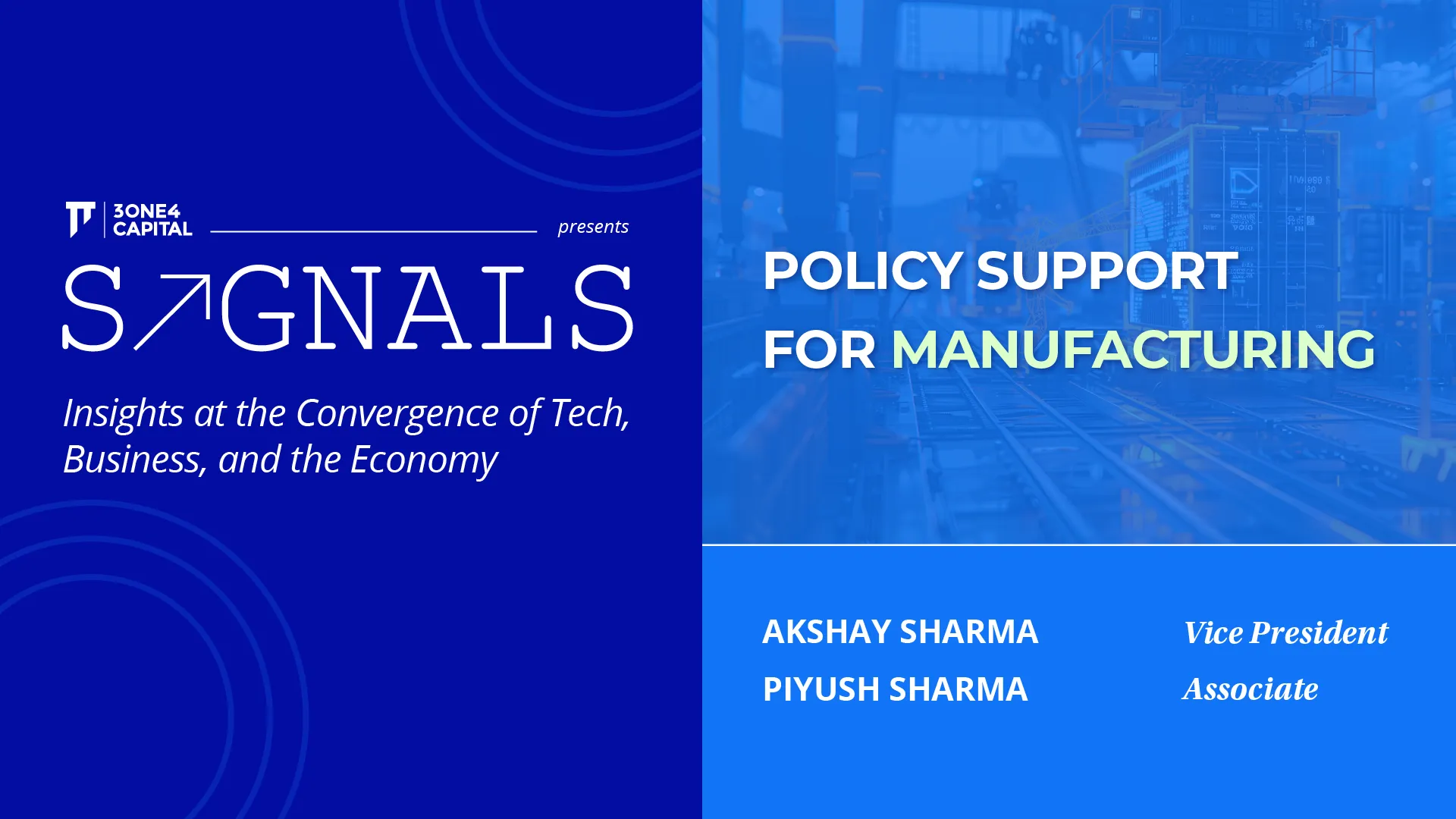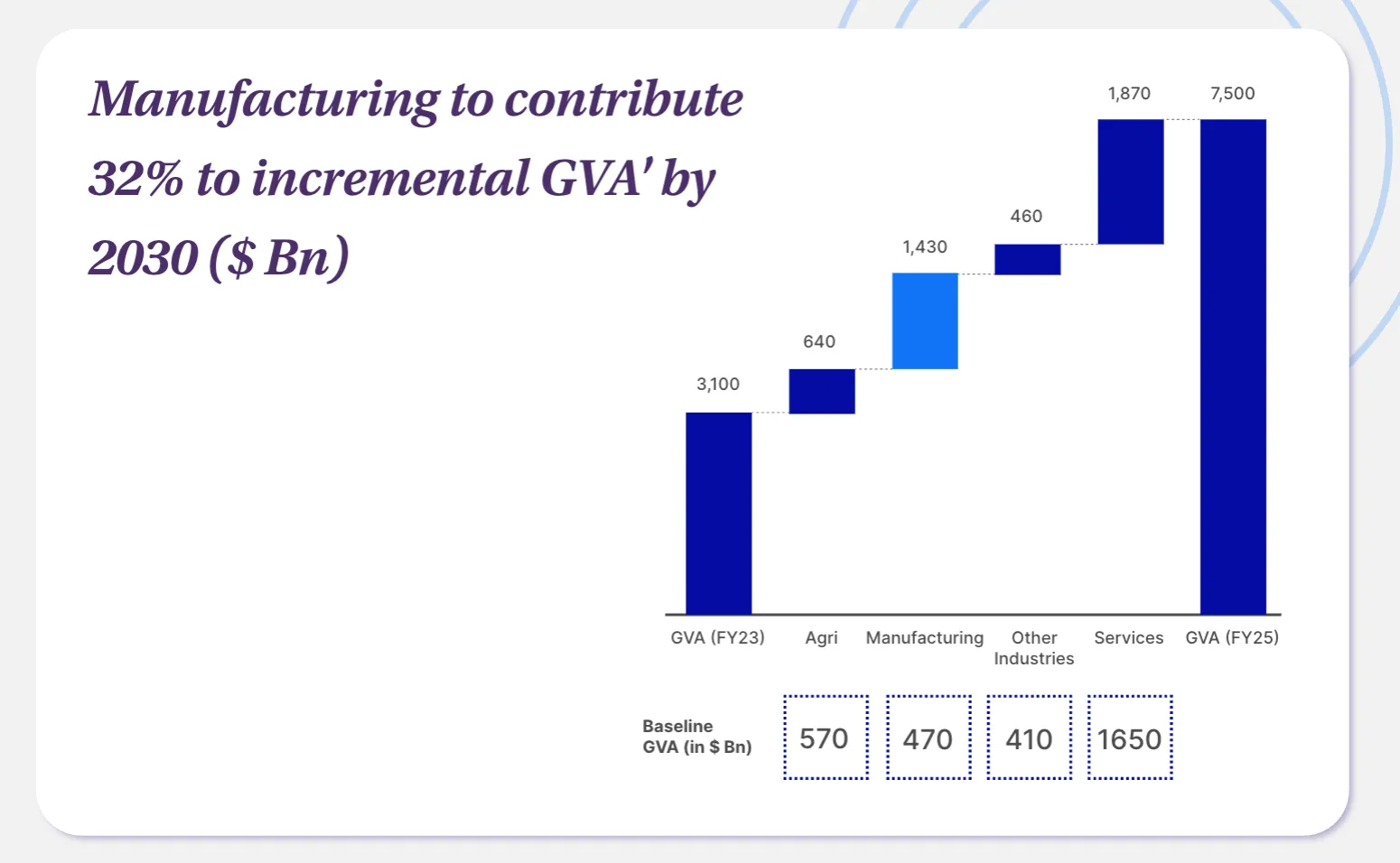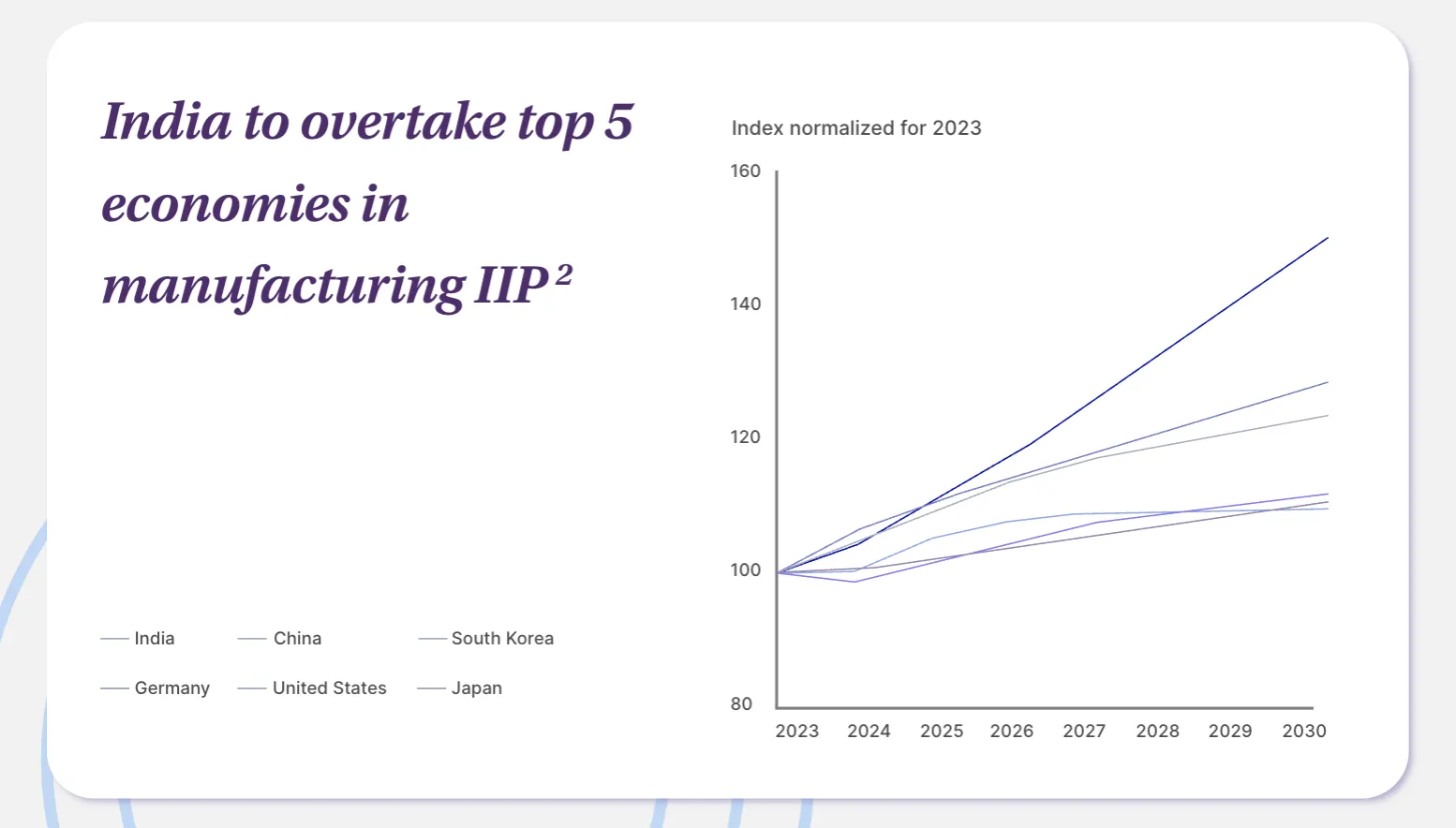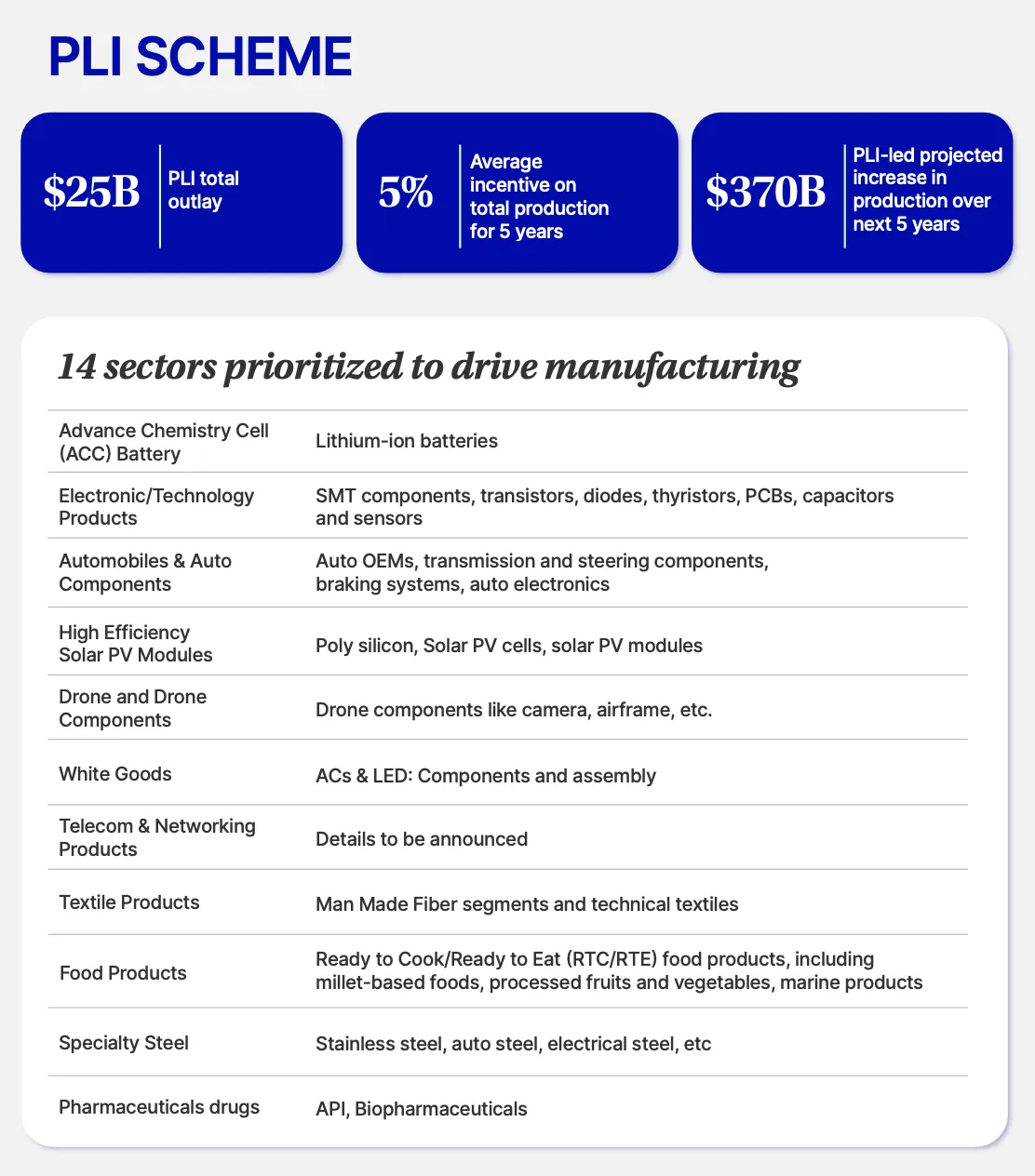
Policy Support for Manufacturing
India's manufacturing sector is rapidly becoming a cornerstone of the country’s economic growth, contributing around 17% to GDP and providing employment for over 50 million people. As the sector continues to expand, it's expected to play an even more significant role, contributing 32% to the incremental Gross Value Added (GVA) that India aims to achieve by 2030. This growth aligns with the government's ‘Make in India’ initiative, which has bolstered global competitiveness and attracted international investment.

The sector's growth trajectory is promising, with a projected compound annual growth rate (CAGR) of 12.5% between 2021 and 2026. As India positions itself as a global manufacturing hub, there are expectations for a substantial rise in industrial output and export capabilities, driving economic value and job creation across various industries.

The Surge in Manufacturing Exports
In recent quarters, Indian manufacturing exports have shown robust growth, with an 8.1% year-on-year increase in Q4 FY24, the highest seen this fiscal year. High-value manufactured goods, including pharmaceuticals, chemicals, engineering products, and electronics, have reached record export levels, boosting the overall growth of merchandise exports in value-added segments. This trend indicates that India is gradually integrating into the global value chain, with a goal of increasing exports to $2 trillion over the next six years.
However, while high-value segments have thrived, growth in the traditional basket of exports continues to decline. The divergence underscores the need for further strategic investments and policy reforms to support traditional export sectors and enhance overall export growth.
Sustained Momentum in Industrial Growth
The manufacturing sector recorded an impressive 8.9% growth in Q4 FY24, demonstrating sustained momentum. The Index of Industrial Production (IIP) also indicates a revival in industrial activity, suggesting that the sector is on an upward trajectory.
Several factors have influenced this growth:
- Modest Investment: Gross fixed capital formation grew by 6.5% year-on-year, a modest pace partly due to uncertainties from national elections, geopolitical tensions in Central Asia, and China's economic slowdown.
- Demand Exceeding Supply: The gap between GDP and GVA has narrowed slightly but remains high, showing that demand is outpacing supply. This suggests robust consumer activity, but it also highlights the need for scaling up production capacities.
- Fiscal Deficit Defying Expectations: The fiscal deficit narrowed to 5.63% of GDP, below initial and revised estimates. This reduction shows the government's focus on maintaining fiscal discipline, even as it invests in growth initiatives.

The above chart showcases positive trend in the direction of high-value manufactured goods increasing than traditional basket, we’re confident that this gap will only increase bringing in significant value to the Indian manufacturing sector. While these are strong signals, we grapple with several challenges that could impact the growth trajectory. Infrastructure deficiencies, complex regulatory environments, and the need for technological upgrades are key hurdles. The sector, however, is poised to benefit from various policy reforms, such as the Production Linked Incentive (PLI) scheme, which aims to inject $26 billion into the industry over the next five years. This support is expected to address critical gaps, enhance competitiveness, and attract foreign investment, potentially boosting manufacturing output and driving India’s share of global manufacturing to over 3% by 2030.
Policy reforms will play a key role to help India becoming the global factory in the longer term. The government has been supportive in injecting capital and taking key initiatives to boost manufacturing in India.


Chemicals Sector: A Key Driver of Growth
A critical component of India's manufacturing ecosystem is its chemical industry, valued at around $212 billion in 2022. With its large consumer base, growing urbanisation, and cost advantages, the sector is projected to grow at 9.3% annually, potentially reaching $2 trillion by 2047. India is already a leading global player in agrochemicals and dyes, ranking 4th and 2nd in production and export, respectively.
Despite its growth potential, the chemical sector faces challenges such as high import dependency for feedstocks and raw materials. However, the focus is shifting toward specialty chemicals and sustainable practices, with the government’s support through favorable policies and incentives. As the sector embraces digital technologies like AI and IoT, it opens up further opportunities for investment and expansion.
Investments and Government Initiatives
To strengthen the sector, the government has been proactive in implementing policies like the National Chemical Policy and the Petroleum, Chemicals, and Petrochemicals Investment Region (PCPIR) scheme. These initiatives aim to create a conducive environment for industry players, with investments in infrastructure, petrochemical complexes, and chemical parks enhancing manufacturing capabilities. Under the Interim Union Budget 2024-25, Rs. 192.21 crore ($23.13 million) was allocated to the Department of Chemicals and Petrochemicals, focusing on attracting investments and fostering growth through the PLI scheme.
Key Highlights:
- FDI inflows in the chemicals sector (other than fertilizers) reached US$ 22.07 billion during April 2000-December 2023
- An investment of Rs 8 lakh crore (US$ 107.38 billion) is estimated in the Indian chemicals and petrochemicals sector by 2025
- During April to December 2023, exports of organic chemicals stood at US$ 5.49 billion & inorganic stood at US$ 1.50 billion
- Imports of organic chemicals were US$ 11.21 billion and inorganic chemicals US$ 5.01 billion from April to December 2023
- The Dahej PCPIR project in Bharuch, has attracted an investment of Rs. 1 lakh crore (US$ 12 billion) and is expected to generate 32,000 jobs

The chemical industry in India is aspiring for the global dominance. With a steady growth rate in its favour, the emergence of India as a global chemical manufacturing hub isn’t a far off possibility
India’s manufacturing sector is at a pivotal juncture, with strong growth prospects driven by government support, robust policy frameworks, and increasing global demand. As the sector evolves, it offers immense opportunities for investment, job creation, and technological advancement. With focused reforms, India is well-positioned to become a global manufacturing powerhouse, particularly in high-value sectors like chemicals, pharmaceuticals, and engineering products.
DISCLAIMER
The views expressed herein are those of the author as of the publication date and are subject to change without notice. Neither the author nor any of the entities under the 3one4 Capital Group have any obligation to update the content. This publications are for informational and educational purposes only and should not be construed as providing any advisory service (including financial, regulatory, or legal). It does not constitute an offer to sell or a solicitation to buy any securities or related financial instruments in any jurisdiction. Readers should perform their own due diligence and consult with relevant advisors before taking any decisions. Any reliance on the information herein is at the reader's own risk, and 3one4 Capital Group assumes no liability for any such reliance.Certain information is based on third-party sources believed to be reliable, but neither the author nor 3one4 Capital Group guarantees its accuracy, recency or completeness. There has been no independent verification of such information or the assumptions on which such information is based, unless expressly mentioned otherwise. References to specific companies, securities, or investment strategies are not endorsements. Unauthorized reproduction, distribution, or use of this document, in whole or in part, is prohibited without prior written consent from the author and/or the 3one4 Capital Group.

.png)












